Sky Phenomena
Geminid meteor composite - Dec.14, 2017
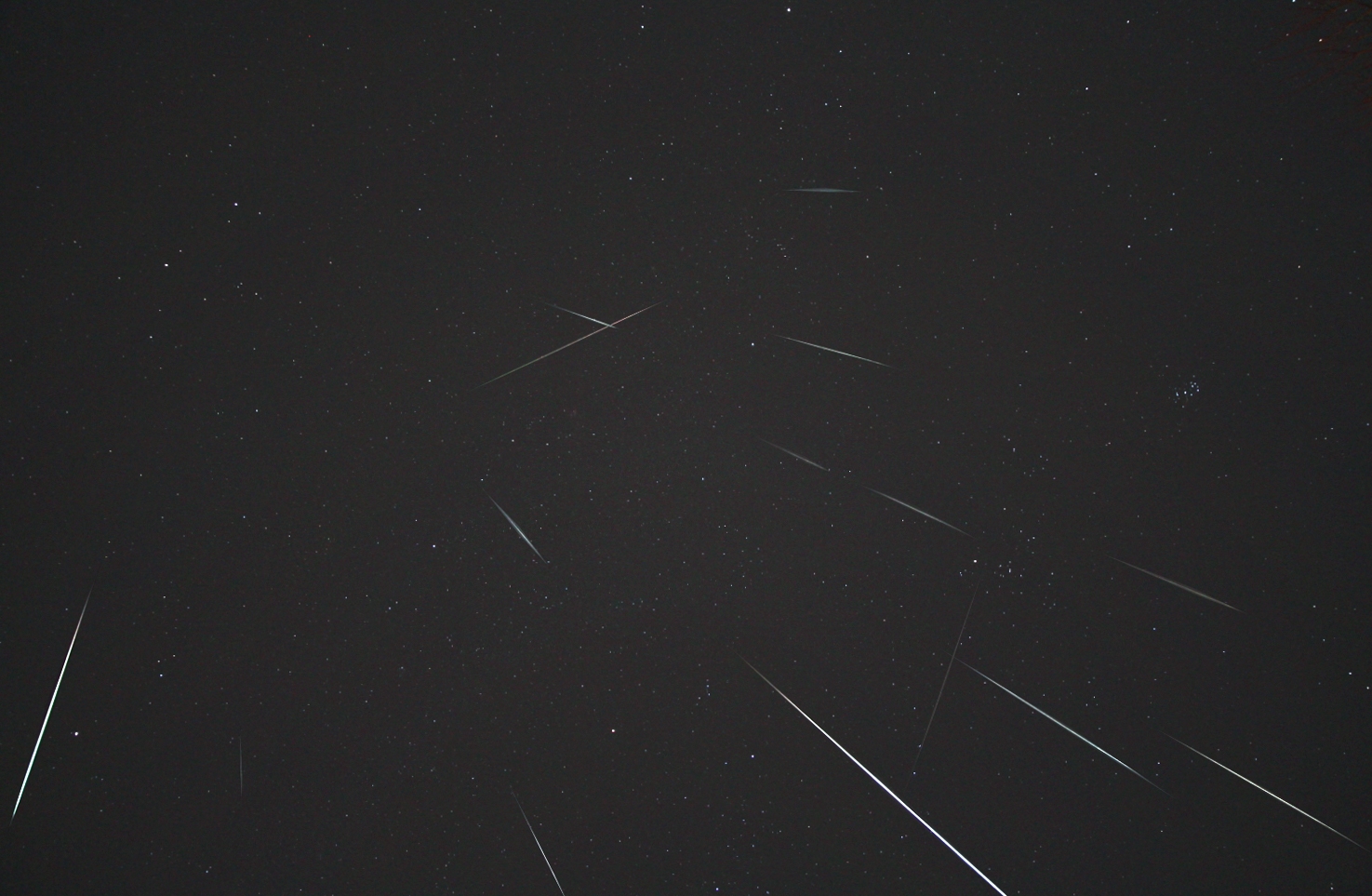
This image is a composite of 13 Geminid meteors plus 2 sporadic meteors
captured on Dec. 14, 2017 between midnight and 3 am.
The sporadic meteors were moving in a different direction than the Geminids.
The Geminids appear to be originating from near the bright star Castor in the constellation Gemini
near the upper left corner.
Pollux is the bright star left of Castor.
The Pleiades, the Hyades, and bright star Aldebaran are seen towards the right side of the image.
Over 2100 images were captured, but only 15 of them had meteors.
I was using my Canon T3i with a Rokinon 16mm lens at f/2 and ISO 800 using 5 second exposures.
The camera was riding on an iOptron Sky Tracker to track the stars.
The imaging session did not start until after midnight due to lingering clouds in the northeast
and lots of Christmas lights brightening my neighborhood.
It was quite windy during the photo shoot.
Photoshop was used to assemble the 15 individual photos into the composite.
Click on the image for a larger view in a new window.
Back to the top of the page
Back to Mark's Astrophotography Home
A Leonid meteor - Nov. 17, 2017
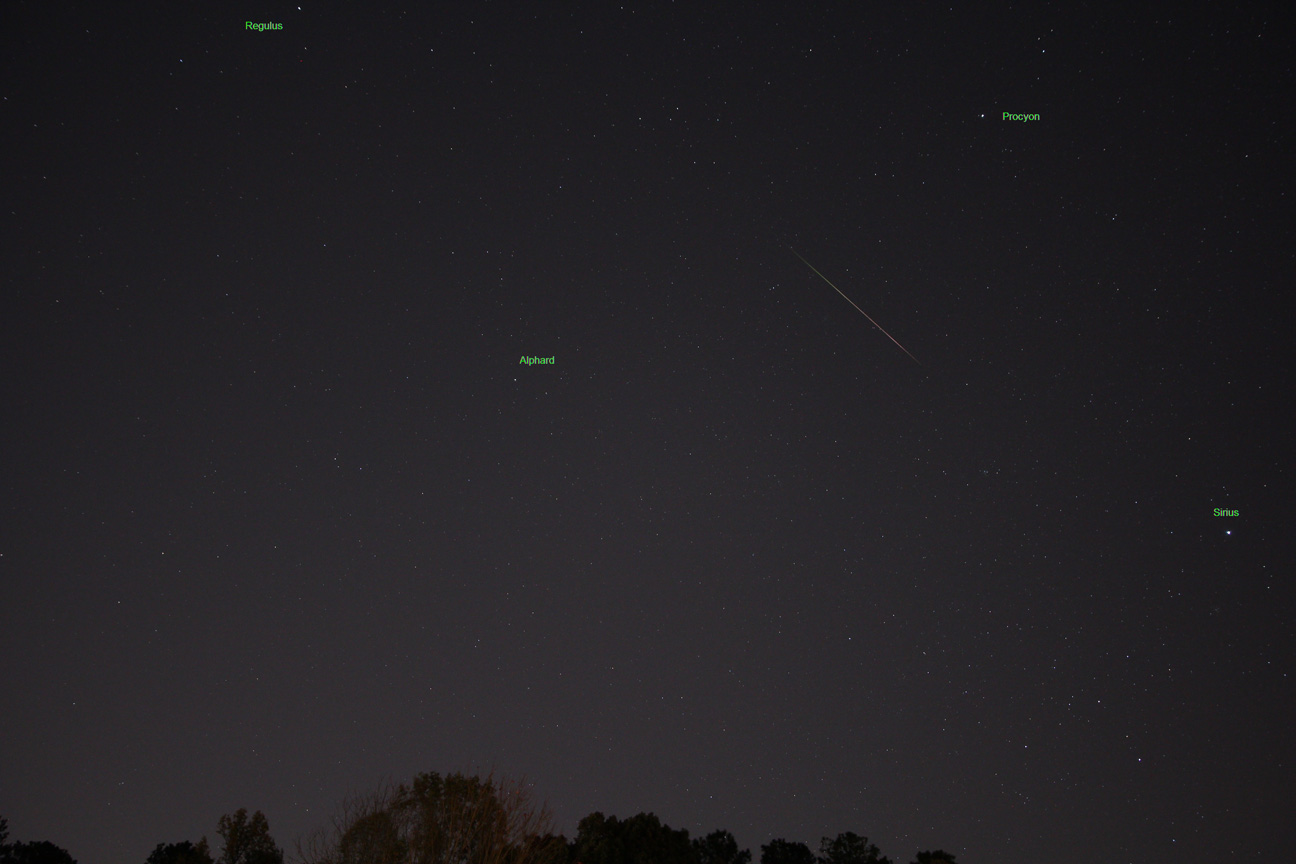
Leonid meteor from Cary, NC. The Leonid meteors peak between Nov. 17 and 18 this year.
I set up my camera in my driveway this morning from 3:30 to 6:00 trying to capture one.
In 800 images, I got one! Note the meteor originates from area to the right of Regulus which is
Alpha Leonis.
This was a single 5 second jpg frame taken with a Canon T3i and Rokinon 16mm f/2 lens.
The star names were added in using MaximDl.
Click on the image for a larger view in a new window.
Back to the top of the page
Back to Mark's Astrophotography Home
Polar star trails over Bigwoods - Feb. 17, 2017
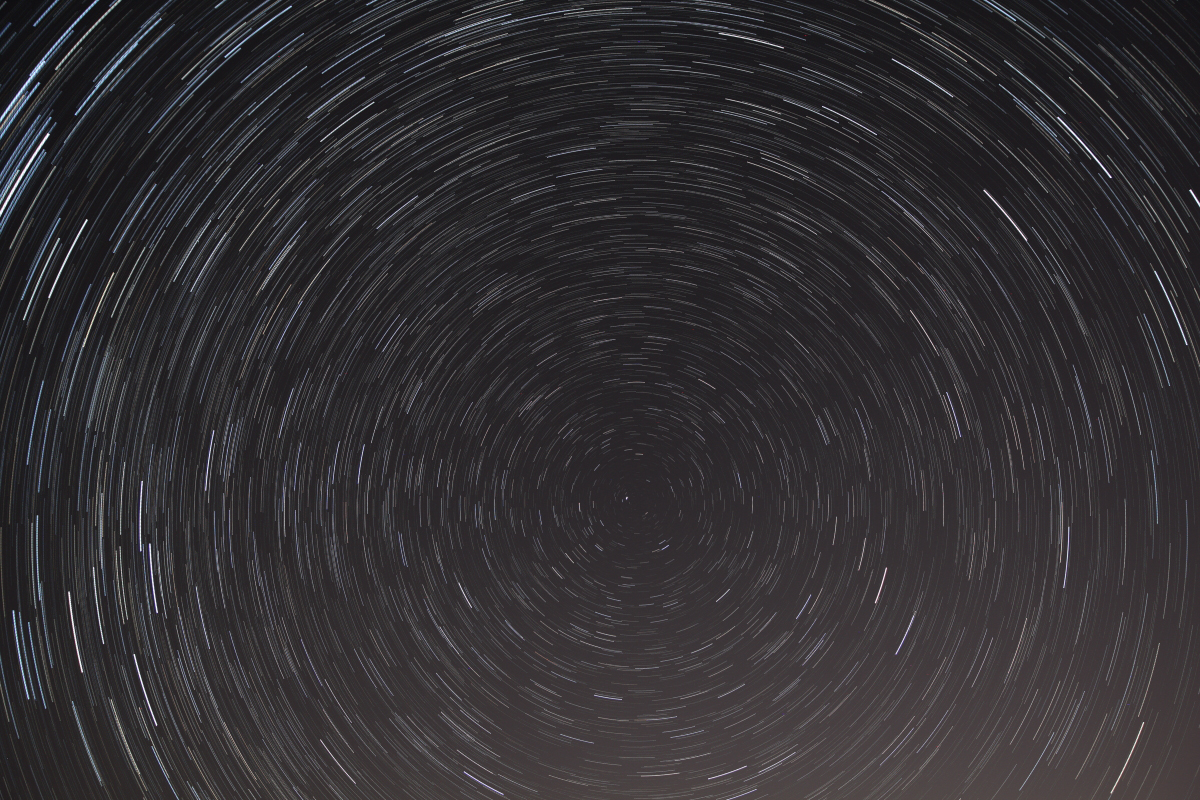
Bigwoods polar star trails taken on a Friday night from 10:30 to 11:00 pm with no airplanes!
This image was created by continuously taking 120 x 15 second images
using my Canon T3i with a Rokinon 16 mm f/2 lens at ISO 800 on a fixed tripod.
The jpg images were resized to 8 x 12 and then
taken into Photoshop CS2 as layers with blending mode set to lighten to create the trails.
Click on the image for a larger view in a new window.
Back to Mark's Astrophotography Home
2016 Perseid Meteor Shower - August 13, 2016
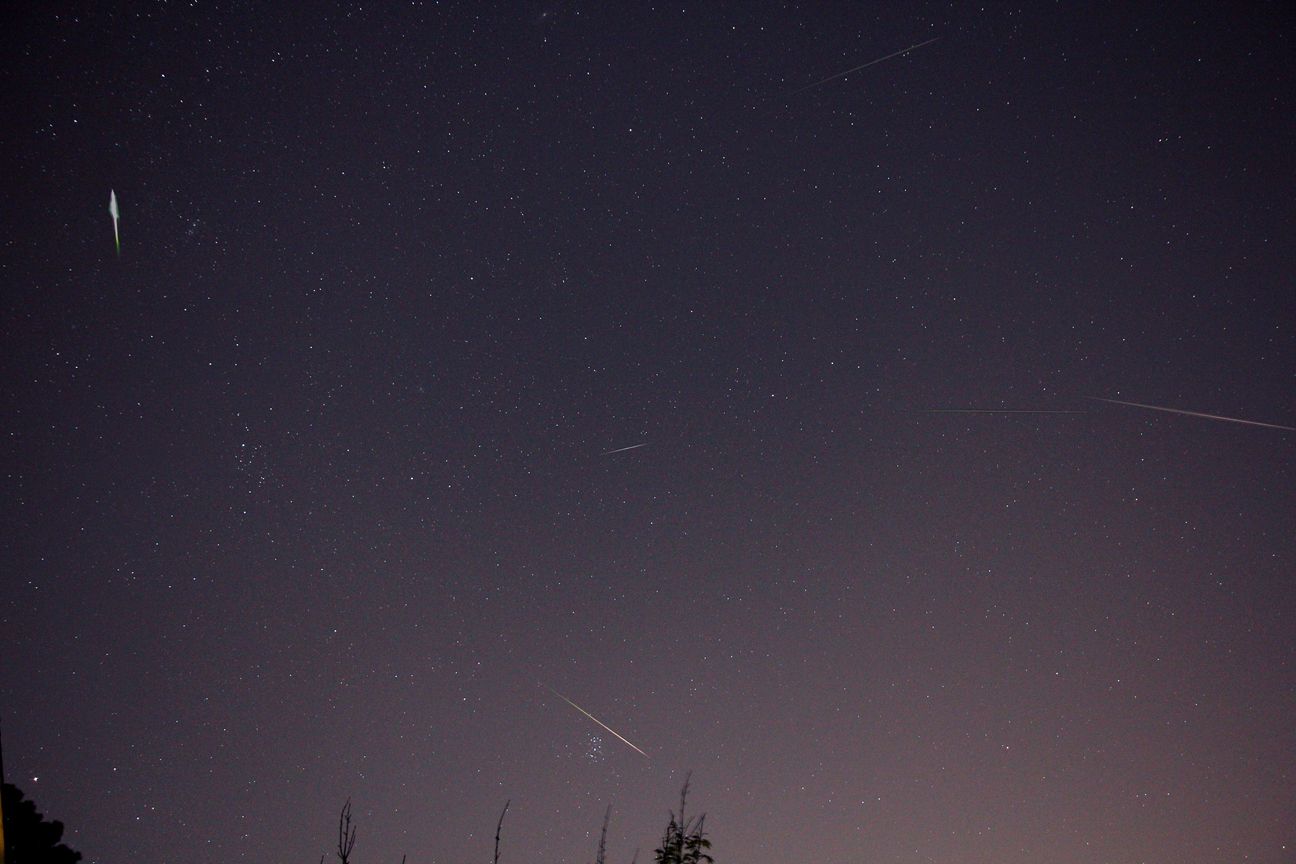
This is a composite photo of five separate images of
the 2016 Perseid meteor show taken from my front yard in Cary, NC.
I was using my unmodified Canon T3i at ISO 1600 with a Rokinon 16mm f/2 lens working at f/2.5.
Each exposure was 8 seconds long.
I took over 900 photos over a three hour period from 2:30 am to 5:30 am, but only used five.
I captured several other meteors that would not fit into the composite image.
The temperature was in the mid 80s.
The images were color corrected with ImagesPlus then given a slight contrast boost.
The composite was made with Photoshop CS2.
I also observed/photographed the shower on Aug. 11 at Bigwoods, but intermittent clouds
were a problem.
Click on the image for a larger view in a new window.
Back to Mark's Astrophotography Home
Aurora over Camp Durant (Raleigh) - Oct.30, 2003
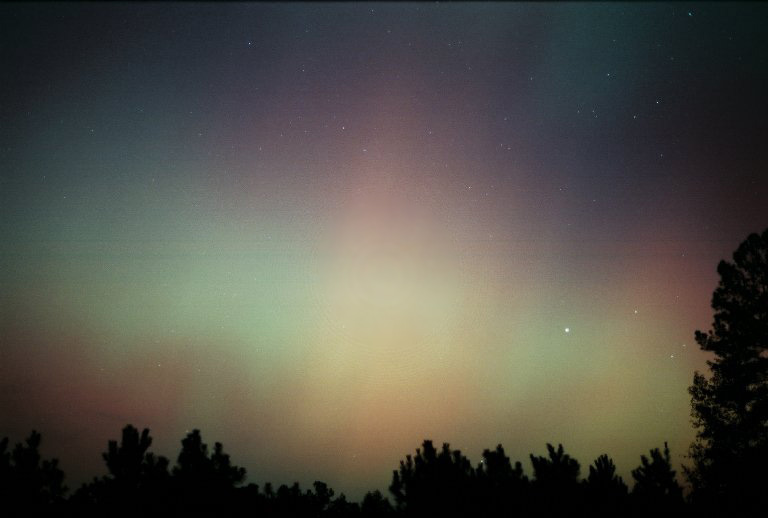
Aurora over North Raleigh Oct. 30, 2003 - As luck would have it, it was Phyllis and my turn to do Blue Jay Point observing session tonight with the Morrisville Elementary fifth graders. I saw the S&T web page article warning of possible auroras, so I took my 35mm camera. As we were starting to set up the telescopes, we saw a beautiful very red aurora in the NE. We also saw some blue-green aurora to the NW. It lasted only a few minutes and was gone. The red auroras kept on going from it's peak around 7:20 until we packed up and left around 8:30.
Back to the top of the pageBack to Mark's Astrophotography Home
Aurora over Bigwods - Sept. 7, 2002
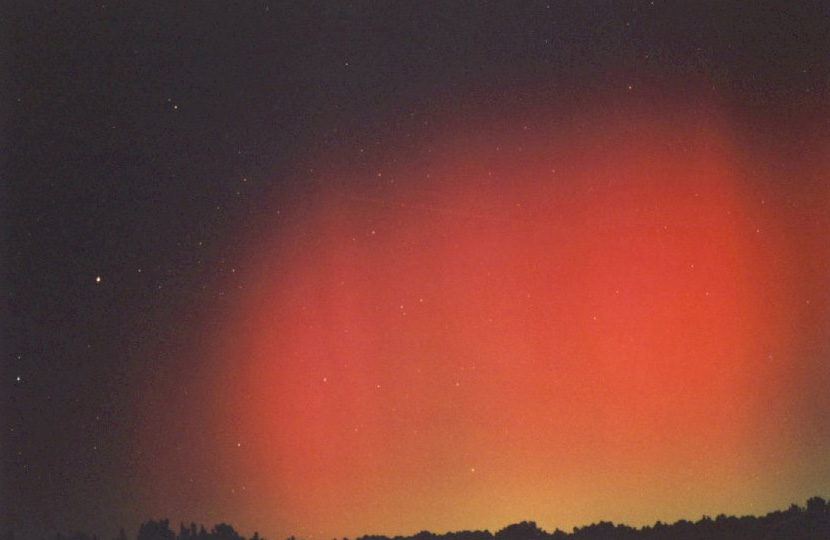
Unexpected Aurora at the Bigwoods observing site Sept. 7, 2002. I had set up my telescopes to do some guided astrophotography when our group noticed a fabulous aurora had started. The conditions, unlike last night, were very good. The aurora started just west of north and moved gradually towards the Big Dipper. It started around 9:15 or so and lasted 10-15 minutes. I saw the colors as pale pink. I took photographs with my 35mm camera that showed it much redder. We could see vertical sheets or curtains coming up from the tree line. After the first display stopped, another started a few minutes later. It lasted about 10 minutes. After all the excitement, I got back to my other photography.
Back to the top of the pageBack to Mark's Astrophotography Home
Crepuscular Rays - Jan. 6, 2007
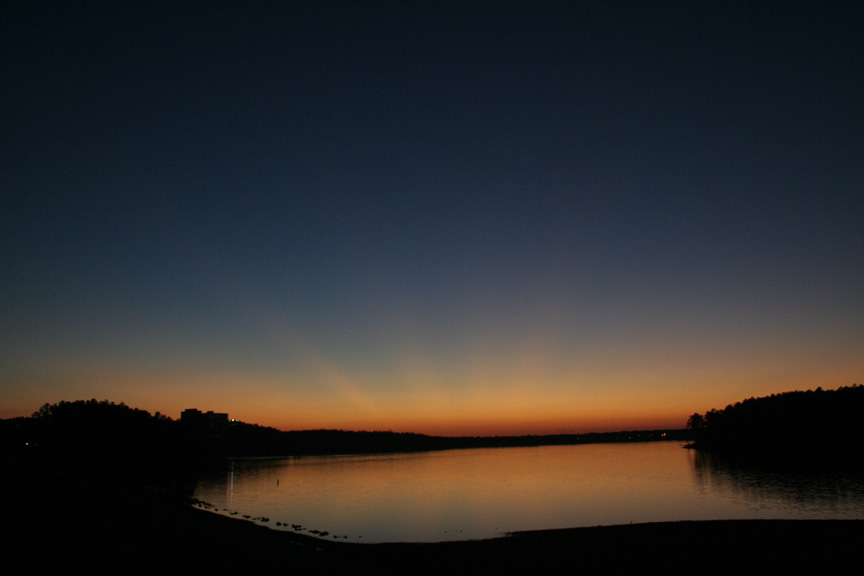
Crepuscular rays over Lake Crabtree seen while searching for Comet McNaught 1/6/2007. Phyllis and I didn't find the Comet, but we did see this nice sunset featuring crepuscular rays. If you look closely Venus can be seen above the horizon to the left center. The comet should have been to it's lower right. Photo taken with a Canon Rebel XT.
Back to the top of the pageBack to Mark's Astrophotography Home
Wide Angle Shot of Andromeda and Cassiopeia - Aug. 12, 2008
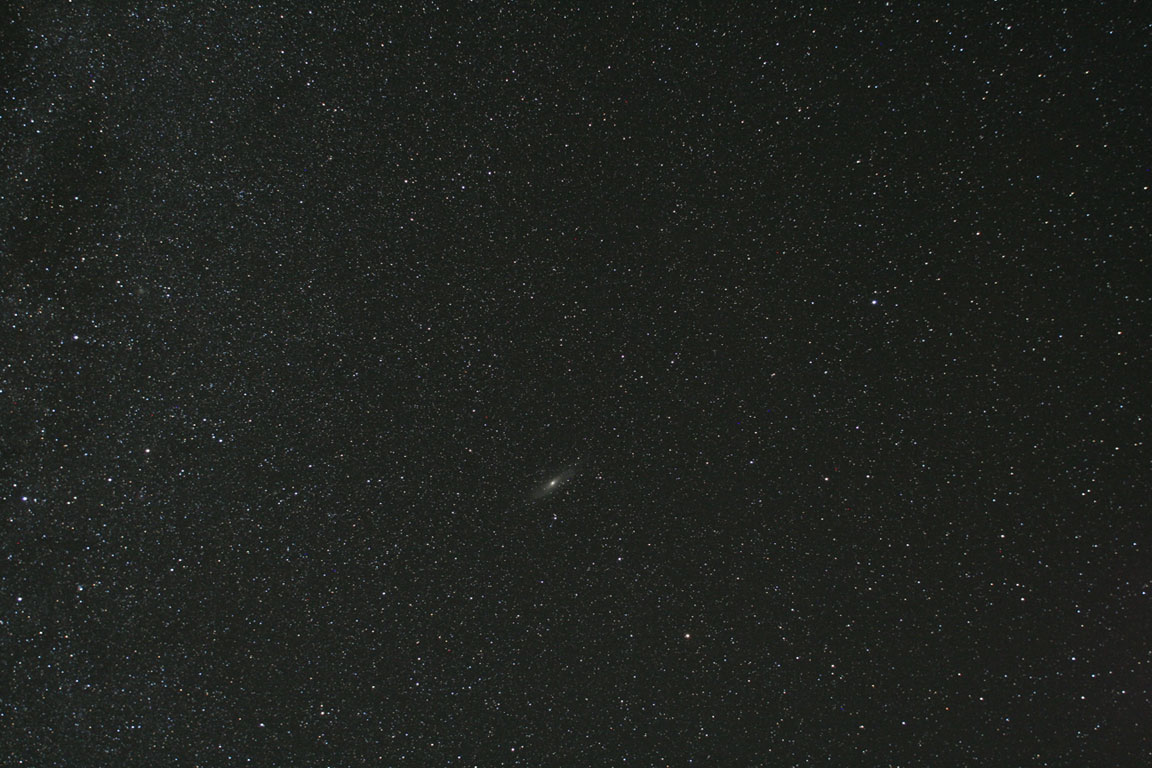
This is what the eastern sky looked like on a camping trip to Grayson Highland State
Park in Virginia back in the summer of 2008.
This park has very dark skies.
This is a single photo taken with an unmodified Canon Rebel XT @ ISO 800
for 150 seconds (2.5 mins) using a Nikor 28mm lens.
North is to the left in the photo.
I was using a home built tracking platform so the camera would move with the sky.
By moving the mouse pointer onto the image you will see the objects identified.
Click on the image to see a larger annotated version in a new window.
Back to Mark's Astrophotography Home
Mars and Saturn moving through Scorpius - August 20-24, 2016

This four night animation shows how the movements of Mars and Saturn made the appearance
of the constellation Scorpius change drastically in late August 2016.
Mars was moving rapidly eastward while Saturn was also moving but at a much slower pace.
The animation was produced from images taken from my front yard in Cary, NC on August 20-24.
August 21 was cloudy so no photo was taken that night.
The four images were taken on a camera tripod with my Canon T3i and its supplied 18-55mm zoom lens.
I was using the lens at 55mm f/4.5.
The camera was set at ISO 1600 and the exposures were 6 seconds.
Click on the image for a larger view in a new window.
Back to Mark's Astrophotography Home
Big Dipper - Sept. 23, 2016
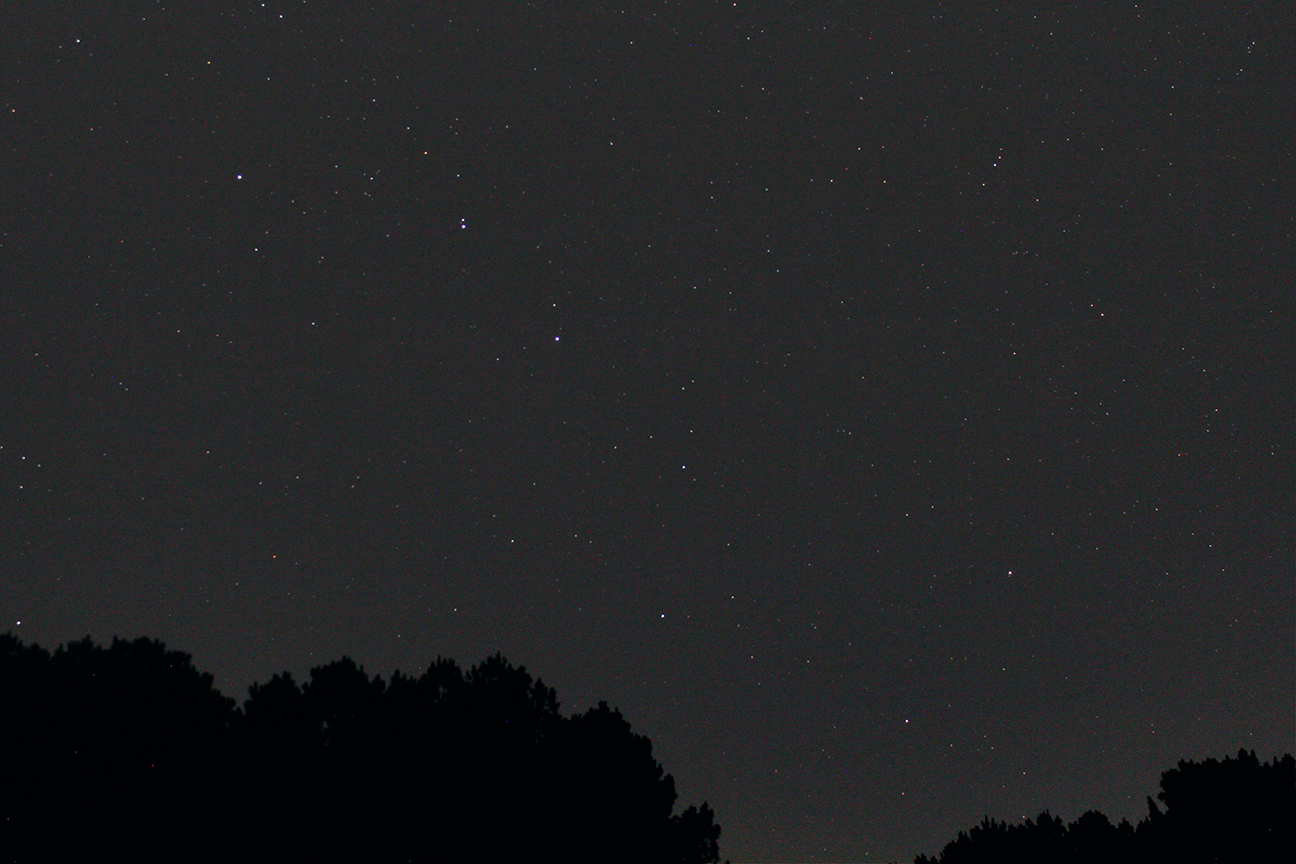
The Big Dipper setting in the NW at Bigwoods.
Notice the colorful double stars Mizar and Alcor in the handle of the dipper.
Photo taken with a Canon Rebel T3i at ISO 800 using the stock 18-55mm lens set at 33mm.
The exposure was 20 seconds at f/5.6.
Click on the photo for a larger view in a new browser window.
Back to Mark's Astrophotography Home
Venus in Gemini - May 13, 2015
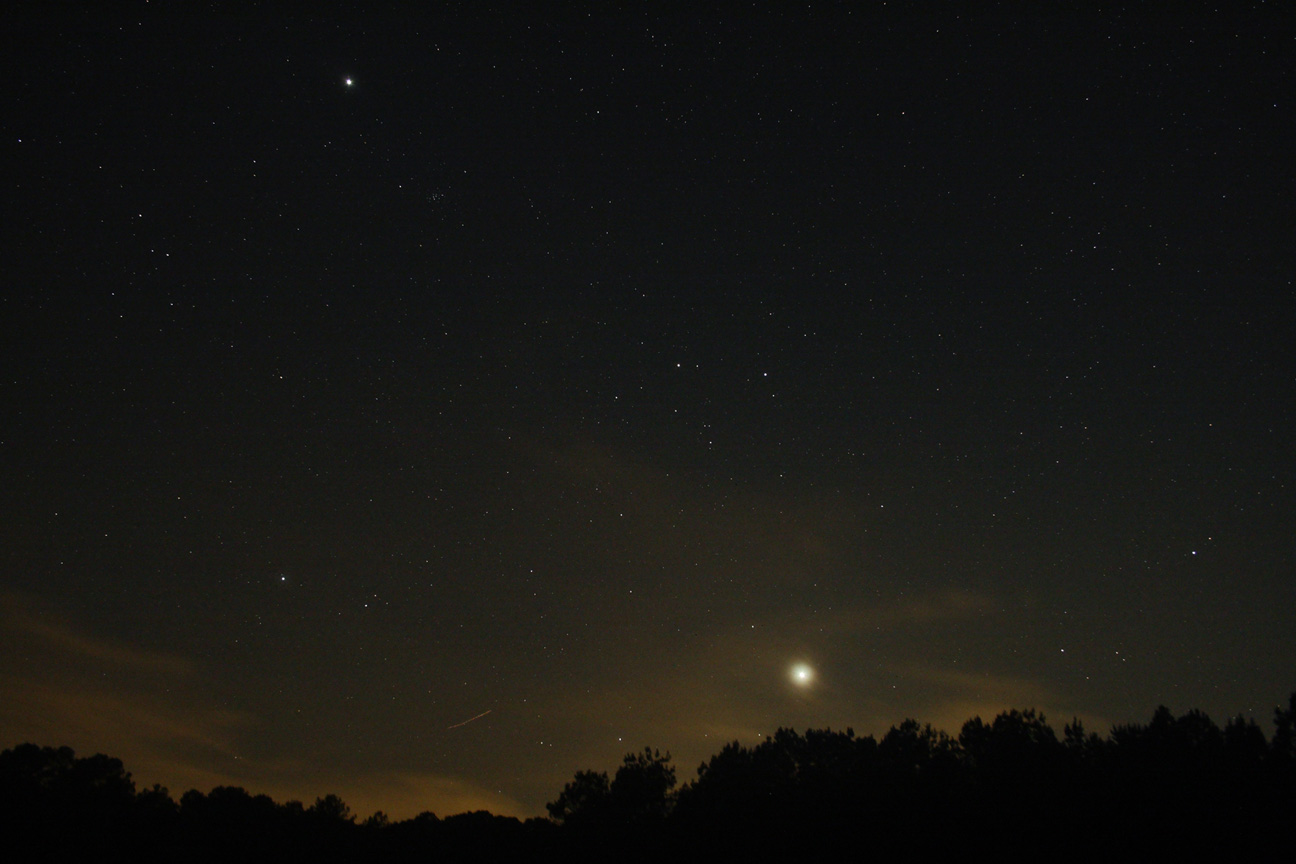
This is view of the western sky at Bigwoods on May 13, 2015 at around 11:45 pm. Venus is the bright object at the feet of Gemini. Jupiter can be seen at the upper left. The photo was taken with my Canon XTi with a kit 18-55 mm lens working at 18mm. Exposure time was 30 seconds at f/5. By moving the mouse pointer onto the image you will see the objects identified. Click on the image to see a larger annotated version in a new window.
Back to the top of the pageBack to Mark's Astrophotography Home
Animation of Canis Major/Orion/Taurus setting - Apr. 3, 2016
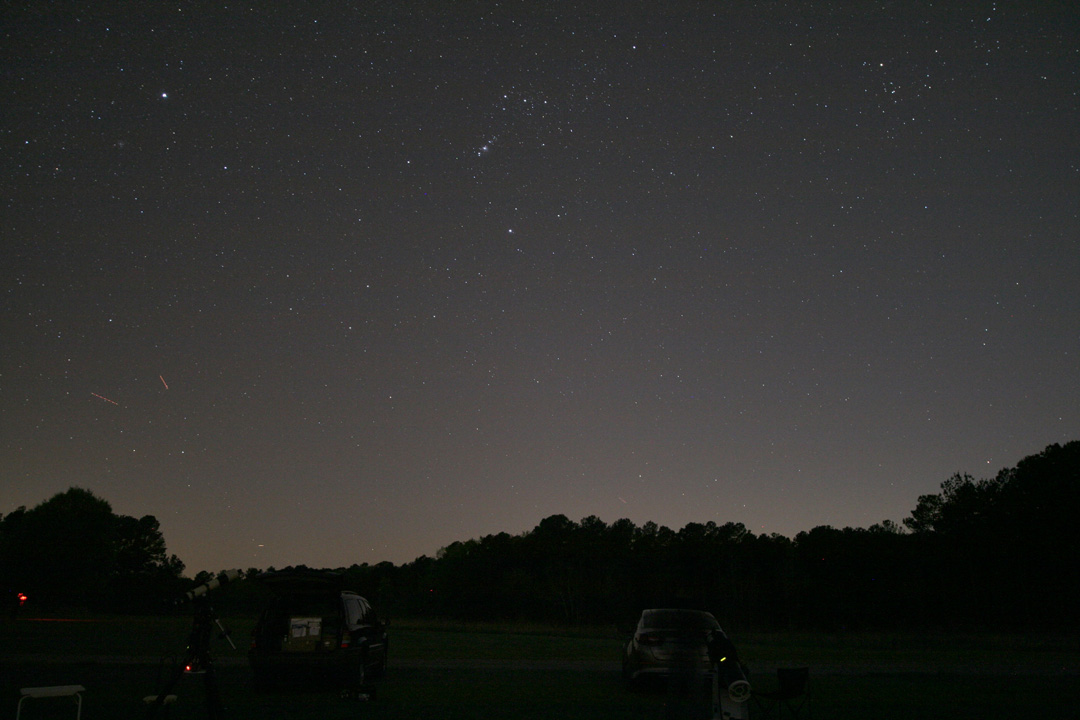
Click on the photo above to see the larger 120 frame animation of this scene in a new window.
The animation was taken at Bigwoods on April 3 showing the southwestern sky.
The animation starts at 7:54 pm and goes until 8:33 pm.
At the upper left is Canis Major with bright star Sirius.
Open cluster M41 is just to the lower left of Sirius.
In the middle of the photo is Orion with M42.
At the upper right is the "V" shape of the Hyades asterism in Taurus.
In the foreground left is me using my Genesis telescope,
and in the center right is John Sadler using his dob.
I used my old unmodified Canon Rebel XT camera at ISO 800 and a Rokinon 16mm f/2 lens
mounted on a tripod to capture the photos.
Ten second images followed by a 10 second gap were taken continuously over 40 minutes.
I used Photoshop CS/2 to create the animation and brighten the scene a bit.
Back to Mark's Astrophotography Home
Milky Setting at the SRSP October 14, 2015
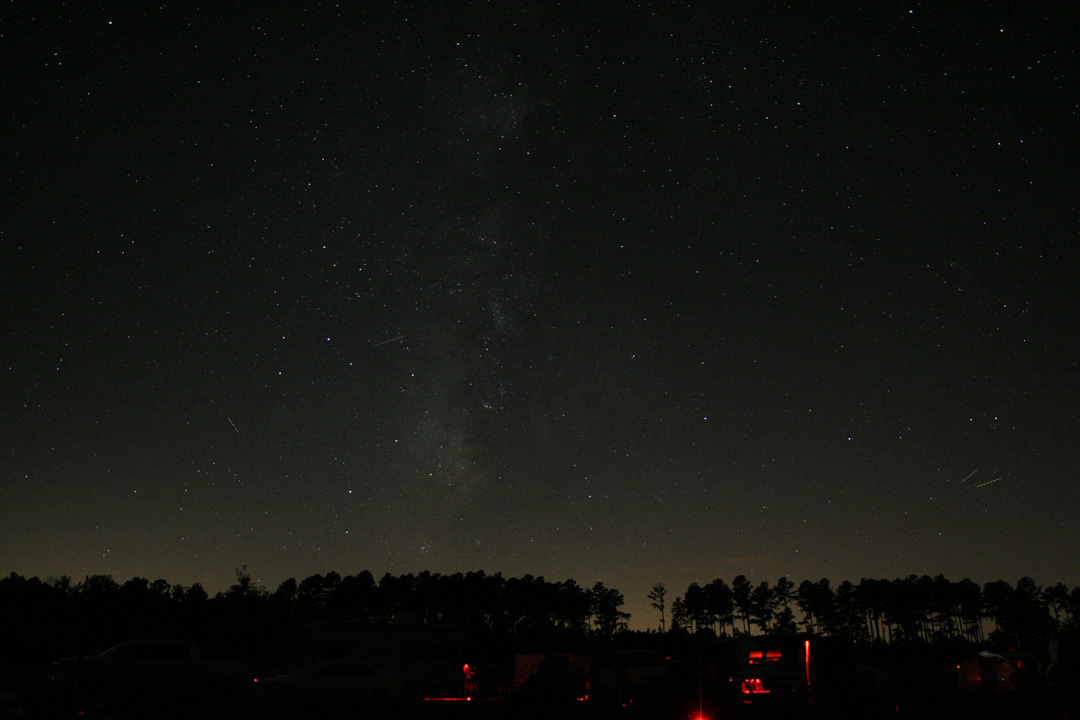
Click on the photo to see a 60 frame animation open in a new window.
The photos were taken at the Staunton River Star Party on Wednesday night Oct. 14 from 7:43 to 9:30 pm.
I used my old Canon Rebel XT camera and a Rokinon 16mm f/2 lens mounted on a tripod.
A ten second image was taken every two minutes.
The dew was really bad shutting many observers and photographers down early.
You can tell about midway into the animation when I used a dew remover to clean the lens.
Back to Mark's Astrophotography Home